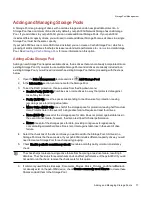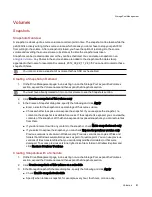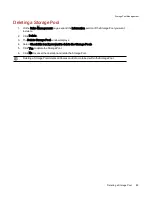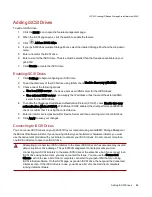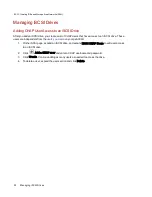
Understanding How Your Content Is Stored
Content on your px6-300d Network Storage is stored in
Shares
and iSCSI volumes. To access content in
Shares, your client computer uses network
protocols
, such as AFP and Windows File Sharing. The px6-
300d's file system maintains the physical location of content that resides in volumes used for Shares.
Block-level data is stored in iSCSI drives. File systems for iSCSI volumes are maintained by the
connected host computer and not the px6-300d.
Shares reside on volumes, which along with iSCSI volumes, reside in Storage Pools. Volumes allow you
to partition space in Storage Pools, and Storage Pools group multiple physical drives together into a single
logical unit to provide redundancy, availability and capacity. All the drives in a Storage Pool must be the
same size and should have the same protection (for example, RAID 5).
All disks within a single Storage Pool must meet the following requirements:
●
Same manufacturer
●
Same rotational speed
●
Same capacity
Mixed disk configurations may result in unpredictable device behavior and will not be supported. If
you need technical assistance, please be prepared to backup your data and remove any
unsupported drives or configurations.
Storage Pools
A Storage Pool is a grouping of drives with a certain storage size and an assigned data protection. A
Storage Pool has a minimum of one drive. By default, your px6-300d has one Storage Pool.
Storage Pool Data Protection
For each Storage Pool, you can select its type of protection. Protection type determines how data is
replicated across a Storage Pool and determines the amount of space used for data protection and
storage. The drives in your px6-300d are protected using a built-in, pre-configured technology that
redundantly stores data across the drives, so that if a single drive fails, in most cases, you will not lose any
data. This technology, known as RAID (Redundant Array of Independent Disks), enables a series of
drives to act together as a single storage system. If you create multiple Storage Pools, you can assign
different
RAID types
to each Storage Pool.
For more information on selecting RAID types, refer to
Changing RAID Protection Types
.
Volumes
A Volume is a single storage area. A volume can be comprised of one or more hard drives. In a single-
volume system, the volume consists of the entire storage space. Shares reside in volumes. iSCSI drives
also reside in volumes.
Storage Pool Management
76
Understanding How Your Content Is Stored
Summary of Contents for StorCenter px6-300d
Page 1: ...px6 300d Network Storage with LifeLine 4 1 User Guide ...
Page 11: ...Setting up Your px6 300d Network Storage Setting up Your px6 300d Network Storage 1 CHAPTER 1 ...
Page 24: ...Setting up Your px6 300d Network Storage 14 Device Setup ...
Page 25: ...Device Configuration Options Device Configuration Options 15 CHAPTER 2 ...
Page 45: ...Users and Groups Users and Groups 35 CHAPTER 4 ...
Page 53: ...Using Active Directory Domain Using Active Directory Domain 43 CHAPTER 5 ...
Page 59: ...Sharing Files Sharing Files 49 CHAPTER 6 ...
Page 80: ...Drive Management Drive Management 70 CHAPTER 7 ...
Page 85: ...Storage Pool Management Storage Pool Management 75 CHAPTER 8 ...
Page 102: ...Backing up and Restoring Your Content Backing up and Restoring Your Content 92 CHAPTER 10 ...
Page 131: ...Sharing Content Using Social Media Sharing Content Using Social Media 121 CHAPTER 13 ...
Page 137: ...Media Management Media Management 127 CHAPTER 14 ...
Page 156: ...Hardware Management Hardware Management 146 CHAPTER 17 ...
Page 163: ...Additional Support Additional Support 153 CHAPTER 18 ...
Page 166: ...Legal Legal 156 CHAPTER 19 ...
















